It seems we can’t find what you’re looking for. Perhaps searching can help.
Earl Stahl
November 2012 - Earl Passed Away In October. This page remembers a good friend and mentor to the Maxecuters and modelers around the world.
|
Earl's Obituary
YORKTOWN - Earl Fred Stahl, Yorktown, Va., died Oct. 16, 2012, at age 94. He was born and raised in Johnstown, Pa. He is survived by his wife of 60 years, Lil; and their daughters, Jeanne E. Stahl and her husband Daniel Elliott, Terri Cuthriell and her husband Michael and Gail Hoilman and Timothy; grandchildren, Seth Hoilman, Shelby and Bryce Cuthriell, and Verity Elliott. He is also survived by his sister, Ruth M. Stahl, of Johnstown, Pa. He served in World War II as a U.S. Army Air Corps Celestial Navigation Instructor. Earl worked at NACA/NASA for 42 years, retiring in 1986 as chief, Operations Support Division. In that role he was awarded the NASA Exceptional Service Medal for "leadership in the management of technical support to the Langley research effort assuring effective utilization of the center's diversified research facilities." Since his youth Earl Stahl was a freelance author and graphics illustrator of model airplanes, sport aviation, and aviation history for various magazines, journals, and World Book Encyclopedia. He remains internationally known for creating and illustrating construction projects for flying model airplanes. Many of his publications continue to be reproduced for competitions in the USA and Europe. In recognition of the "enduring and distinguished achievement in the art of free flight model aviation," he was inducted into the halls of fame of five national hobby organizations. The family requests that no flowers be sent. Arrangements by Amory Funeral Home, Grafton. View and post condolences on our online guestbook at dailypress.com/guestbooks. |
Some thoughts and photos from Lindsey Smith "The first was taken at Geneseo in ‘94, he is holding my version of his Apache which I built to bring over to fly in rubber scale. He was kind enough to say that ‘It showed great promise’ and later sent me the other shot of him launching the original prototype in 1942 which was covered in red tissue. . He was such a nice chap, I always sent him a photo of the entrants in our annual Stahl contest at Wallop, and he always sent a nice reoly untill ‘09 after which I expect he was too frail. Anyway ,Regards to all over there. Lindsey" |
|
Earl with Lindsey's Apache at Geneseo. 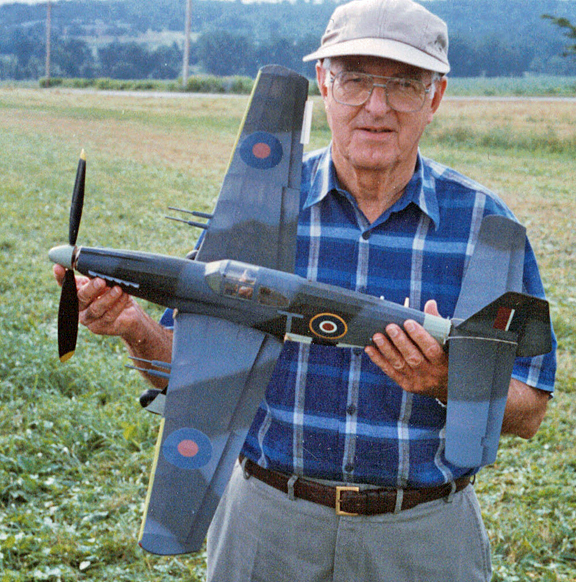
|
A youthful Earl enjoying scale free flight with his Apache. 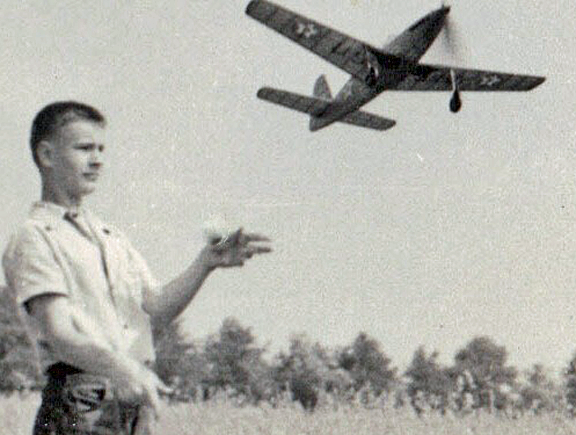
|
|
Lindsey and fellow British modelers at an annual "Earl Stahl' low/high wing contest. 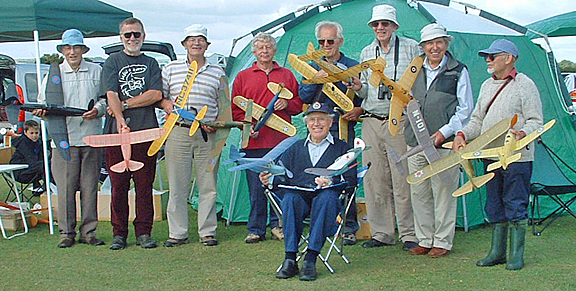
|
Lindsey's MIG from Earl's plan. 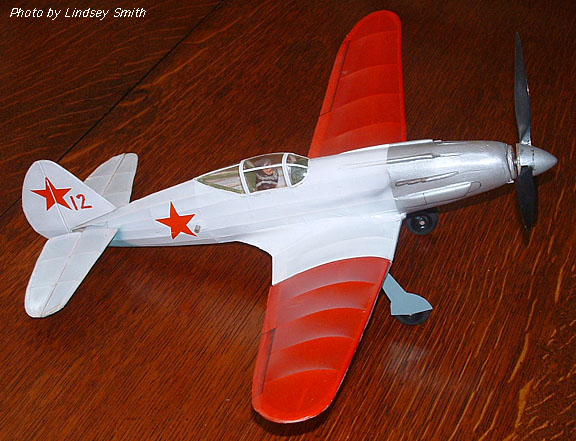
|
|
From the KAPA KOLLECTO
R
Louis N. Buffardi, Editor EARL STAHL- WIZARD OF FLYING SCALE By Jim Alaback When it cones to flying scale models, Earl Stahl's designs are not only well remembered, they are still being built in large numbers more than 50 years later. They are, in fact, a staple of vintage and modern flying scale contest events all over the world. Earl, not quite nine years old, was already hooked on model building when Lindbergh made his non-stop, solo flight from New York to Paris in May, 1927. It was to be a lifetime hobby for him, as it has been for so many of us. Today he may be seen at Society of Antique Modelers and Flying Aces Club contests, and we are proud to say that he is a Founding Member of Kits and Plans Antiquitous. Growing up in Johnstown, Pennsylvania, Earl became an avid contest flyer in the 1930s. As a teenager. Earl participated in the regional events sponsored by the newspapers, such as Junior Birdmen (Hearst) and Junior Aviator (Scripps Howard) as well as national contests and the Wakefield. Getting to out-of-town contests was a challenge. Earl's family did not have an automobile so he rode Greyhound from Johnstown to places like Detroit, Chicago, Akron, and Cleveland. Safely transporting eight or ten models was a problem. Storage for big items of baggage on those old busses was under canvas on the roof. To protect his models, in their homemade cases, he would insist on cliinbing the chromed ladder at the back to assure their proper placement and retrieval. No transportation casualties ever occuredl In Johnstown at this time there were a dozen or so extremely active modelers. This little group included two others who would rise to national prominence as contestants and designers- Ted Just and Alfred Cleave. Earl and his house were the center of their activities which, except in the bitter winters, included model flying almost every day in a nearby park or at a small, grassy airport. Earl's first published plan was for his "Weight Rule Contest Model", in the June, 1938, issue of Model Airplane News. This was followed, in August, 1939, by his "Hi-Climber" in Flying Aces. The DeHavilland Leopard Moth was the first scale model that Earl built. It was from a George D. Wanner Co. kit that he won as a contest prize. It was a good flyer and its nice appearance stimulated a new interest for him- flying scale models! He obtained a 3-view outline drawing of the Rearwin Speedster. He designed a model of the Speedster, using the experience he obtained in designing his earlier contest models. It turned out to be a superb flyer. He sent a picture of his model to C. H. Grant, then the editor of Model Airplane News. Grant invited Earl to prepare the plan and article which appeared in the January, 1940 issue. I well remember receiving that issue and the immediate appeal of the design. Like all of Earl's scale models it had a great beauty of line. In fact, I have often thought that his model designs, like Varga's paintings of girls, were even sleeker than the originals! Following the success of the Rearwin, Earl produced a long series of his splendid scale designs for publication in all three of the leading model publications of the day- Flying Aces, Model Airplane News, and Air Trails. Despite his tremendous success with flying scale rubber powered model designs, Earl continued to design contest models. His "Hurricane" and (Wakefield) "Gypsy" designs were published in Flying Aces in July, 1940, and September, 1942, respectively. In February, 1944, his "Class D Contest Model" was published in |
M.A.N. This model had actually been designed and built in 1938, but publication
in the magazine was delayed. This design has recently been recognized as "legal" for competition in Society of Antique Modelers'" competition even though the design's publication had been delayed past SAM's December, 1942, cut-off date. Earl also moved on to other types of model designs for publication. These included his free-flight gas Fokker D-8 {M.A.N., June and July, 1941), a couple of scale towline gliders, and three solid scale models for Air Trails in 1943. After the war, Earl designed two controline scale models, a Vought F4U Corsair and a Cessna 140. The latter was published in Mechanix Illustrated instead of one of the model magazines, and probably had a larger circulation than any of his other plans. He had another design, a Piel Sneraude free flight for .020 engine, published in 1960, and a rubber-powered General Skyfarer (his second) published in Model Builder, June 1975. Recently Earl commented on the accuracy of his scale designs with these words: "...a few have questioned the authenticity of those old designs. The information explosion upon us has made available much more data on most any aircraft than was obtainable, at least to me, in those earlier days. The point to be made is that a sincere effort was made to be as accurate as material at hand permitted." For scale documentation. Earl relied heavily on Aero Digest magazine. Their "annual" issue, each March, cost the then-pricely sum of 50<P but it contained tiny 3-views of all the current airplanes, along with specifications and a picture of each. Fortunately, a friend of his had access to a photostat machine and could enlarge the 3-views to ease Earl's drafting burden. Earl says those enlargements had big, fuzzy lines that looked like they had been drawn with the wet end of a cigar butt I Later, Earl became a private pilot and was actually flying some of these planes at the time he modeled them. The Taylorcraft Tandem ("O-57") was one example and the Cessna 140 was another. When he is asked which of his models was his own favorite, Earl says there was no single one, but he does cite the Waco E and the Hawker Hurricane for beauty and the Interstate Cadet and General Skyf arer for their flying ability* For a combination of appearance and performance he remembers the North American Apache, a semi-scale model published in Air Trails, March, 1942. In retrospect, Earl says that he could have done more work on optimizing propellers. Once he settled on a length, width, and pitch, that was it. On the subject of props he also says, "Incidentally, I do not admire the use of the manufactured, plastic propellers which is common today. They are probably better than our handcarved ones of days gone by but I do believe skillful fashioning of a prop presents the greatest challenge in the construction of a rubber powered model, so I like to see that effort on the part of the builder." Earl's first employment was with All American Aviation (which later became Allegheny and is now U.S.Air). He then went on to a productive 40-year career at NACA/NASA, from which he is now retired. Earl wrote recently, "Doing those articles was genuine fun. Unfortunately, I had the feeling that the construction articles were being received with indifference by the readers. Oh, I got letters from Europe, Africa, South America, and Australia but the editors, aside from never rejecting an article, made few comments or recommendations... For several decades after I stopped submitting the articles I supposed the various models had been forgotten. Then,,in recent years, letters, phone calls, and visitors... have made me aware that many folks had built and enjoyed the models. It is a source of pleasure to be aware that some of the designs are still being built and flown." Click here for Jim Alaback's Plan List http://www.theplanpage.com/esp/planlist.htm |
|
Earl's first published design "Weight Rule Contest Model" held by Adam Parshall.
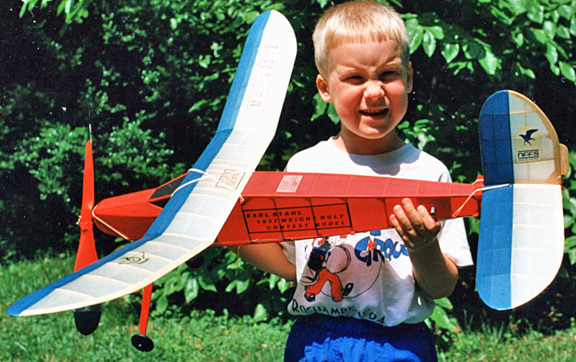
|
Believe this is a model
from Earl's last published plan
(Piper Pawnee) by John Lewars seen here with Earl at Genseo.

|
With the Brainbusters.

With Wally Farrell and Dave Rees. 
Earl launching at a Virginia contest. 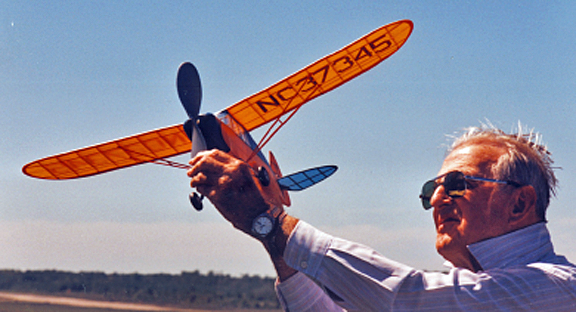
|
Some photos from he Braincbusters and others of Earl enjoying the local contests,
He was a faithful devotee of the Brainbuster's "Cloud Tramp" contests seen here here with the Club and Abram Van Dover. 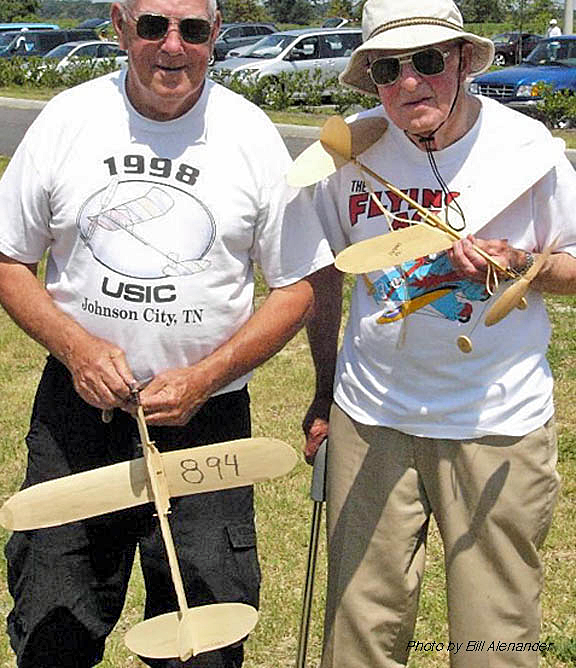
|
It seems we can’t find what you’re looking for. Perhaps searching can help.